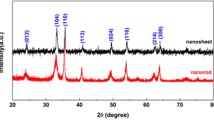Abstract
Well-crystallized FeSbO4 nanorods with rutile-like structure are synthesized through a solid-state reaction and used as cathode material of Li-ion battery for the first time. The obtained nanorods can react with ∼11 Li-ions per FeSbO4 unit with a specific discharge capacity of 1 100 mAh·g− between 0.1 and 2.0 V. Three discharge plateaus can be observed during the fully discharging process, but the reversible reaction with ∼1 Li occurs between 1.5 V and 4.5 V vs. Li+/Li, and the reversible capacity is only 50–80 1 mAh·g−. FeSbO4 nanorods have a stable cyclic performance between 1.5 V and 4.5 V and it can be used as cathode material for rechargeable Li-ion battery.
Similar content being viewed by others
References
Whittingham M S. Lithium batteries and cathode materials [J]. Chemical Reviews, 2004, 104: 4271–4302.
Palacin M R. Recent advances in rechargeable battery materials: A chemist’s perspective [J]. Chemical Society Reviews, 2009, 38: 2565–2575.
Ellis B L, Lee K T, Nazar L F. Positive electrode materials for Li-ion and Li-batteries [J]. Chemistry of Materials, 2010, 22: 691–714.
Cheng F, Liang J, Tao Z, et al. Functional materials for rechargeable batteries [J]. Advanced Materials, 2011, 23: 1695–1715.
Hu Y S, Kienle L, Guo Y G, et al. High lithium electroactivity of nanometer-sized rutile TiO2 [J]. Advanced Materials, 2006, 18: 1421–1426.
Jiao F, Bruce P G. Mesoporous crystalline beta-MnO2: A reversible positive electrode for rechargeable lithium batteries [J]. Advanced Materials, 2007, 19: 657–660.
Pfanzelt M, Kubiak P, Fleischhammer M, et al. TiO2 rutile: An alternative anode material for safe lithium-ion batteries [J]. Journal of Power Sources, 2011, 196: 6815–6821.
Reddy M V, Rao S G V, Chowdari B V R. Chowdari. Nano-(V1/2Sb1/2Sn)O4: A high capacity, high rate anode material for Li-ion batteries [J]. Journal of Materials Chemistry, 2011, 21: 10003–10011.
Simonin L, Lafont U, Tabrizi N, et al. Sb/O nano-composites produced via Spark Discharge Generation for Li-ion battery anodes [J]. Journal of Power Sources, 2007, 174: 805–809.
Xue M Z, Fu Z W. Electrochemical reaction of lithium with nanostructured thin film of antimony trioxide [J]. Electrochemistry Communications, 2006, 8: 1250–1256.
Kundu M, Mahanty S, Basu R N. Lithium antimonite: A new class of anode material for lithium-ion battery [J]. Electrochemistry Communications, 2009, 11: 1389–1392.
Larcher D, Prakash A S, Laffont L, et al. Reactivity of antimony oxides and MSb2O6 (M=Cu,Ni,Co), trirutile-type phases with metallic lithium [J]. Journal of the Electrochemical Society, 2006, 153: A1778–A1787.
Morales J, Sanchez L, Martin F, et al. Electrochemical reaction of lithium with nanosized vanadium antimonate [J]. Journal of Solid State Chemistry, 2006, 179: 2554–2561.
Perez-Flores J C, Kuhn A, Garcia-Alvarado F. Electrochemical performances of BiSbO4 as electrode material for lithium batteries [J]. Journal of Power Sources, 2008, 182: 365–369.
Nag P, Banerjee S, Lee Y, et al. Sonochemical Synthesis and Properties of Nanoparticles of FeSbO4 [J]. Inorganic Chemistry, 2012, 51: 844–850.
Grau-Crespo R, Moreira I D R, Illas F, et al. The effect of cation coordination on the properties of oxygen vacancies in FeSbO4 [J]. Journal of Materials Chemistry, 2006, 16: 1943–1949.
Grau-Crespo R, de Leeuw N H, Catlow C R A. Catlow. distribution of cations in FeSbO4: A computer modeling study [J]. Chemistry of Materials, 2004, 16: 1954–1960.
Koudraichova M V, Harrison N M, de Leeuw S W. Diffusion of Li-ions in rutile. An ab initio study [J]. Solid State Ionics, 2003, 157: 35–38.
Huang Y, Ruiz P. The nature of antimony-enriched surface layer of Fe-Sb mixed oxides [J]. Applied Surface Science, 2006, 252: 7849–7855.
Author information
Authors and Affiliations
Corresponding authors
Additional information
Foundation item: Supported by the Program for New Century Excellent Talents in University (NCET-07-0637) and the Fundamental Research Funds for the Central Universities (2081003) of China
Biography: ZHANG Qinggang, male, Ph.D. candidate, research direction: cathode material of lithium ion battery.
Rights and permissions
About this article
Cite this article
Zhang, Q., Hu, X., Zhan, D. et al. Synthesis and electrochemical properties of FeSbO4 nanorods. Wuhan Univ. J. Nat. Sci. 18, 185–190 (2013). https://doi.org/10.1007/s11859-013-0912-1
Received:
Published:
Issue Date:
DOI: https://doi.org/10.1007/s11859-013-0912-1




